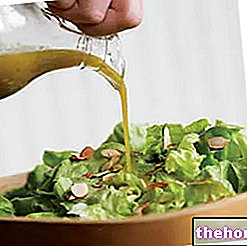From seeds to soybean oil
Soybean oil is extracted from the seeds of the plant of the same name, which contain it in an amount equal to 15-25% of the dry weight, in relation to the variety considered, the cultivation techniques and the seasonal variability.

Nutritional Properties
Soybean oil is very rich in polyunsaturated fatty acids; in particular, the content in linoleic acid (precursor of the omega-six series, 58% ca) and in alpha-linolenic acid (precursor of the omega-three series, stands out) 4-10%). The content of oleic acid is also good (19-30%), while compared to other vegetable oils there is a clear lack of vitamin E. This characteristic, together with the abundant presence of polyunsaturated fats, makes the soybean oil particularly subject to oxidative processes, with a consequent tendency to premature rancidity of the product. To limit this phenomenon, many producers operate a partial hydrogenation of the product, the same that - when performed in a more thorough way - allows to convert soybean oil into margarine. Unfortunately, all these industrial processes end up impoverishing the precious nutritional virtues of the product. crude soybean oil, now available only in health food stores.
Like all vegetable oils, soybean oil also contains a small amount of saturated fats, in particular stearic acid (4% c.a.) and palmitic acid (10% c.a.).
The qualitative-quantitative composition in fatty acids, as well as the examination of the production processes, allows to formulate a judgment in light and shade. In fact, the content of omega-three, fats present only in trace amounts in most seed oils, is discreet; this characteristic, together with the richness in omega-six and oleic acid, gives the soybean oil interesting cholesterol-lowering properties. This effect, attributable to all vegetable oils, is however valid only when the oil is used sparingly ( to avoid introducing too many calories and gaining weight) and in partial replacement (not in addition) to animal fats. Furthermore, it is important that the diet contains at the same time important sources of omega-three, such as fish and its oil, to rebalance the relationship between these nutrients and omega-six. In crude soybean oil there are also moderate quantities of lecithin, which also has hypocholesterolemic properties and potentially useful in the presence of neurological diseases due to its ability to promote the regeneration of myelin sheaths. G.
negative judgments can instead be expressed on the low content of vitamin E, very important for limiting the phenomena of peroxidation to which polyunsaturated fatty acids (PUFA) are subject. As anticipated, this characteristic is also responsible for the rancidity of the product, and can be corrected through the partial hydrogenation of the oil; Unfortunately, it is however known that the hydrogenation processes lead to the formation of trans fatty acids, which at high doses have a negative effect on plasma cholesterol levels (they raise the bad one and reduce the HDL fraction). In recent years, this "problem" of richness in highly oxidizable alpha linolenic acid has been bypassed at the origin through genetic engineering, which has led to the selection of soy varieties with very low alpha linolenic acid content. This is suitable for frying, since this use should be reserved only for fats rich in oleic acid, such as olive, peanut, avocado and some varieties of sunflower. By contrast, traditional soybean oil should therefore only be used raw.
Ultimately, there are no particular reasons to prefer refined soybean oil, which we normally find on supermarket shelves, to other seed oils, much less to the more precious olive oil. The situation changes for virgin and raw products. "(in fact, a correction is always necessary), cold pressed and available in specialized stores; these soybean oils are in fact particularly rich in nutrients that are precious for the health of the organism. The ideal, however, is to often rotate the type of oil used in the kitchen, since each vegetable source has its own peculiarities.
A final note should be made on the use of soybean oil in the chemical industry, for the preparation of paints, lubricants, adhesives, resins, plastics, etc.
Other Foods - Oils and Fats Peanut Butter Cocoa Butter Butter Greaves Wheat Germ Animal Fats Margarine Vegetable Cream Tropical Oils and Fats Frying Oils Vegetable Oils Peanut Oil Borage Oil Rapeseed Oil Krill Oil Poppy Seed Oil Seed Oil Pumpkin Avocado oil Hemp oil Safflower oil Coconut oil Cod liver oil Wheat germ oil Linseed oil Macadamia oil Corn oil Almond oil Hazelnut oil Walnut oil Olive oil Palm oil fish Rapeseed oil Rice oil Pomace oil Seed oil Soybean oil Grapeseed oil Extra virgin olive oil Sesame seeds and sesame oil Lard OTHER ARTICLES OILS AND FATS Categories Food Alcoholics Meat Cereals and derivatives Sweeteners Sweets Offal Fruit Dried fruit Milk and Derivatives Legumes Oils and Fats Fish and fishery products Salami Spices Vegetables Health recipes Appetizers Bread, Pizza and Brioche First courses Seconds pi acts Vegetables and Salads Sweets and Desserts Ice creams and sorbets Syrups, liqueurs and grappa Basic Preparations ---- In the Kitchen with leftovers Carnival recipes Christmas recipes Light diet recipes for Celiacs Recipes for Diabetics Recipes for Holidays Recipes for Valentine's Day Recipes for Vegetarians Protein Recipes Regional Recipes Vegan Recipes




























